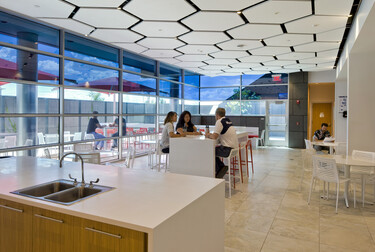How Buildings Make People Better, in Dollars

More productive, more creative, more engaged, happier…these are among the many benefits scores of studies have shown organizations reap from creating better buildings for their people. Even though there is robust data behind these findings, the data is empirical, not financial. In the real estate industry, financial metrics are the primary decision driver.
For this reason, real estate services firm STOK undertook the effort to take the scores of studies and translate them into the financial metrics that motivate the real estate community...and the results are impressive.
Quantifying the “Human Dollar” impact of high performance buildings
Their full report outlines the methodology in detail, but at its core, the study evaluated the findings of 35 peer-reviewed studies published over the years which examined how buildings impacted occupants. By assuming a hypothetical office building, along with some assumed financial parameters such as discount rate and inflation, they were able to translate this data into total net present value figures, per employee, across three key dimensions: employee productivity, retention, and health and wellness.
Their analysis reveals that high-performance buildings provide:
- $23,584/employee in net present value over ten years
- $3,395 incremental annual profit per employee
- $18.56 incremental annual profit per square foot
These data points show the tremendous value organizations, and the real estate industry, can reap from investing in high performance buildings. So…case closed right? The data is in, it’s based on decades of solid research so everyone will undoubtedly buy in and the market will transition to constructing high performance buildings as the norm. Except for one thing.
Doubt…The Elephant in the Room
While STOK’s report is revealing, it is not in fact new research. They aggregated lots of existing data, added some hypotheticals, and then generated data designed to speak the language of the CRE community. In the end, the CRE industry is still somewhat skeptical and risk-averse. We can all anticipate the likely question in response to this data: “How do I know that my project will benefit in this way? Is it even possible to measure all this for my project if I wanted to?” Pragmatists always ruin a good thing with simple questions that are hard to answer. In fairness, how can any owner or investor be confident that their high-performance building will deliver these human performance benefits which in turn help their bottom line?
A reasonable bet, not a leap of faith
The skepticism is reasonable, but we need to be honest that iron-clad guarantees of these outcomes are not in the foreseeable future. But is that the test we must employ for high-performance building investment? Is the bar that high for other investments?
Let’s start with the example of financial investments. Financial investments carry different degrees of risk. You examine past performance, future indicators, and the assumed level of risk and you make a call.
For analogies closer to our subject, stok mentions employee wellness programs which typically cost around $700/employee per year. These are ubiquitous today because decades of research showed such programs, with adequate uptake, reduce long-term healthcare costs. Organizations don't typically require a guarantee that their wellness program will deliver in this way… doing so is practically impossible as the timeline for analysis is far too long.
In the end, we are left with a basic fact: there is very strong evidence suggesting high-performance buildings result in positive occupant impacts that can improve an organization’s bottom line. It is not a sure thing, but at the very least it’s a reasonable bet, one even a stubborn pragmatist can get behind.